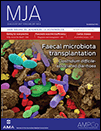Diagnosis and management of pancreatic exocrine insufficiency
Abstract
Introduction: In 2015, the Australasian Pancreatic Club (APC) published the Australasian guidelines for the management of pancreatic exocrine insufficiency (http://pancreas.org.au/2016/01/pancreatic-exocrine-insufficiency-guidelines). Pancreatic exocrine insufficiency (PEI) occurs when normal digestion cannot be sustained due to insufficient pancreatic digestive enzyme activity. This may be related to a breakdown, at any point, in the pancreatic digestive chain: pancreatic stimulation; synthesis, release or transportation of pancreatic enzymes; or synchronisation of secretions to mix with ingested food.
Main recommendations: The guidelines provide advice on diagnosis and management of PEI, noting the following:
- A high prevalence of PEI is seen in certain diseases and conditions, such as cystic fibrosis, acute and chronic pancreatitis, pancreatic cancer and pancreatic surgery.
- The main symptoms of PEI are steatorrhoea or diarrhoea, abdominal pain, bloating and weight loss. These symptoms are non-specific and often go undetected and untreated.
- PEI diagnosis is predominantly based on clinical findings and the presence of underlying disease. The likelihood of PEI in suspected patients has been categorised into three groups: definite, possible and unlikely.
- If left untreated, PEI may lead to complications related to fat malabsorption and malnutrition, and have an impact on quality of life.
- Pancreatic enzyme replacement therapy (PERT) remains the mainstay of PEI treatment with the recommended adult initial enzyme dose being 25 000–40 000 units of lipase per meal, titrating up to a maximum of 75 000–80 000 units of lipase per meal.
- Adjunct acid-suppressing therapy may be useful when patients still experience symptoms of PEI on high dose PERT.
- Nutritional management by an experienced dietitian is essential.
Changes in management as a result of these guidelines: These are the first guidelines to classify PEI as being definite, possible or unlikely, and provide a diagnostic algorithm to facilitate the early diagnosis of PEI and appropriate use of PERT.




